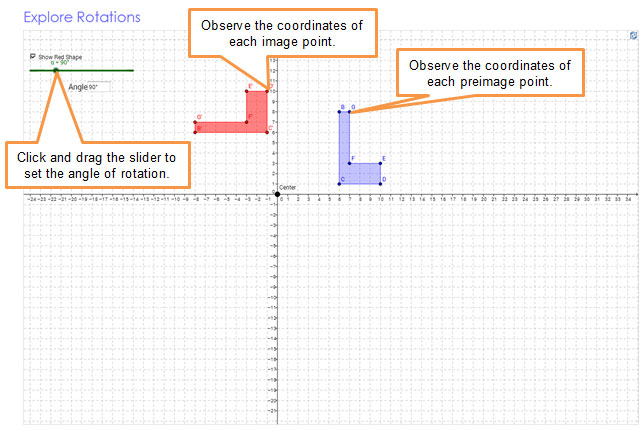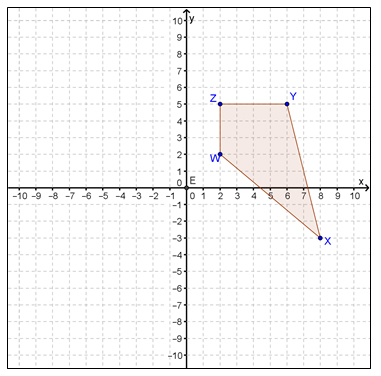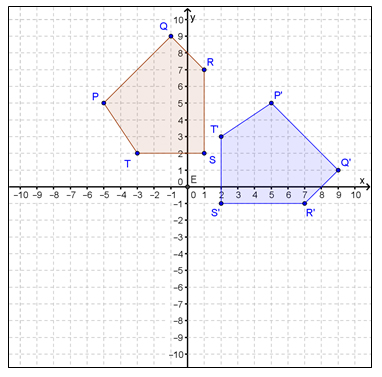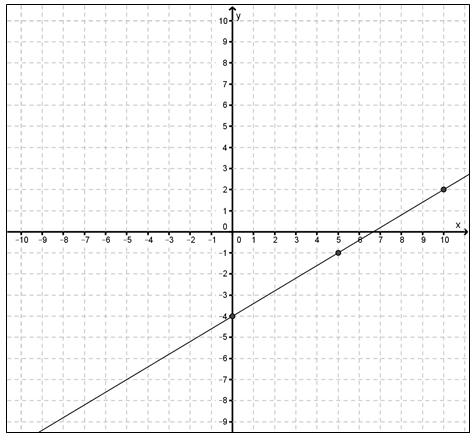In the past, you investigated coordinate translations, reflections, and dilations. Translations are transformations that slide, or translate, a figure over a coordinate plane. Reflections are transformations that create mirror images of figures. Dilations are transformations that generate enlargements or reductions of figures.
In this section, you will extend what you know about coordinate transformations rotations in multiples of 90° and look for patterns in the coordinates.
![]() Click the image below to open an interactive sketch in a new browser tab or window. Once you have opened the sketch, use the slider to change the angle of rotation to 90° counter-clockwise. Locate the coordinates of the image of the rotation, and complete the table below. Use your table to answer the questions that follow.
Click the image below to open an interactive sketch in a new browser tab or window. Once you have opened the sketch, use the slider to change the angle of rotation to 90° counter-clockwise. Locate the coordinates of the image of the rotation, and complete the table below. Use your table to answer the questions that follow.
Click to seeInteractive popup. Assistance may be required.

 in using the interactive sketch.
in using the interactive sketch.
Use the interactive sketch to complete the following table for a 90° counter-clockwise rotation. Make a copy of the table in your notes. Fill in the columns for Original Coordinates using the coordinates of hexagon BCDEFG, which is the preimage of the rotation. Fill in the columns for Rotated Coordinates using the coordinates of hexagon B'C'D'E'F'G', which is the image of the rotation.
Image Point |
Original Coordinates |
Rotated Coordinates |
B |
||
C |
||
D |
||
E |
||
F |
||
G |
Image Point |
Original Coordinates |
Rotated Coordinates |
B |
(6, 8) |
(-8, 6) |
C |
(6, 1) |
(-1, 6) |
D |
(10, 1) |
(-1, 10) |
E |
(10, 3) |
(-3, 10) |
F |
(7, 3) |
(-3, 7) |
G |
(7, 8) |
(-8, 7) |

Use your completed table to answer the questions that follow.
Interactive popup. Assistance may be required.
The x-coordinate of the rotated coordinates has the opposite sign of the y-coordinate of the original coordinates.
Interactive popup. Assistance may be required.
If a polygon is rotated 90° counterclockwise around the origin, the coordinates of each point in the polygon are changed by the following rule:
Use the interactive sketch to complete the following table for a 180° counter-clockwise rotation. Make a copy of the table in your notes. Fill in the columns for Original Coordinates using the coordinates of hexagon BCDEFG, which is the preimage of the rotation. Fill in the columns for Rotated Coordinates using the coordinates of hexagon B'C'D'E'F'G', which is the image of the rotation.
Image Point |
Original Coordinates |
Rotated Coordinates |
B |
||
C |
||
D |
||
E |
||
F |
||
G |
Image Point |
Original Coordinates |
Rotated Coordinates |
B |
(6, 8) |
(-6, -8) |
C |
(6, 1) |
(-6, -1) |
D |
(10, 1) |
(-10, -1) |
E |
(10, 3) |
(-10, -3) |
F |
(7, 3) |
(-7, -3) |
G |
(7, 8) |
(-7, -8) |

Use your completed table to answer the questions that follow.
Interactive popup. Assistance may be required.
The x-coordinate of the rotated coordinates has the opposite sign of the x-coordinate of the original coordinates.
Interactive popup. Assistance may be required.
If a polygon is rotated 180° counterclockwise around the origin, the coordinates of each point in the polygon are changed by the following rule:
Use the interactive sketch to complete the following table for a 270° counter-clockwise rotation. Make a copy of the table in your notes. Fill in the columns for Original Coordinates using the coordinates of hexagon BCDEFG, which is the preimage of the rotation. Fill in the columns for Rotated Coordinates using the coordinates of hexagon B'C'D'E'F'G', which is the image of the rotation.
Image Point |
Original Coordinates |
Rotated Coordinates |
B |
||
C |
||
D |
||
E |
||
F |
||
G |
Image Point |
Original Coordinates |
Rotated Coordinates |
B |
(6, 8) |
(8, -6) |
C |
(6, 1) |
(1, -6) |
D |
(10, 1) |
(1, -10) |
E |
(10, 3) |
(3, -10) |
F |
(7, 3) |
(3, -7) |
G |
(7, 8) |
(8, -7) |

Use your completed table to answer the questions that follow.
Interactive popup. Assistance may be required.
The x-coordinate of the rotated coordinates is the same as the y-coordinate of the original coordinates.
Interactive popup. Assistance may be required.
If a polygon is rotated 270° counterclockwise around the origin, the coordinates of each point in the polygon are changed by the following rule:
Use the interactive sketch to change the angle of rotation to 360° counter-clockwise. Use the results to answer the questions that follow.
Interactive popup. Assistance may be required.
The image and preimage overlap, because a 360° rotation is a full turn.
Interactive popup. Assistance may be required.
If a polygon is rotated 360° counterclockwise around the origin, the coordinates of each point in the polygon are changed by the following rule: (x, y) → (x, y)
How are a 90° counterclockwise rotation about the origin and a 270° clockwise rotation alike? How are they different?

If WXYZ is rotated 90° counterclockwise about the origin, what will be the coordinates of the image of WXYZ?

What is the algebraic rule that best describes the rotation?

Interactive popup. Assistance may be required.

![]() Sketch the results of each transformation for a figure of your choice, and compare the two images (use a reflection interactive, rotation interactive, or translation interactive if necessary). Which of the three pairs gives you the same image?
Sketch the results of each transformation for a figure of your choice, and compare the two images (use a reflection interactive, rotation interactive, or translation interactive if necessary). Which of the three pairs gives you the same image?
